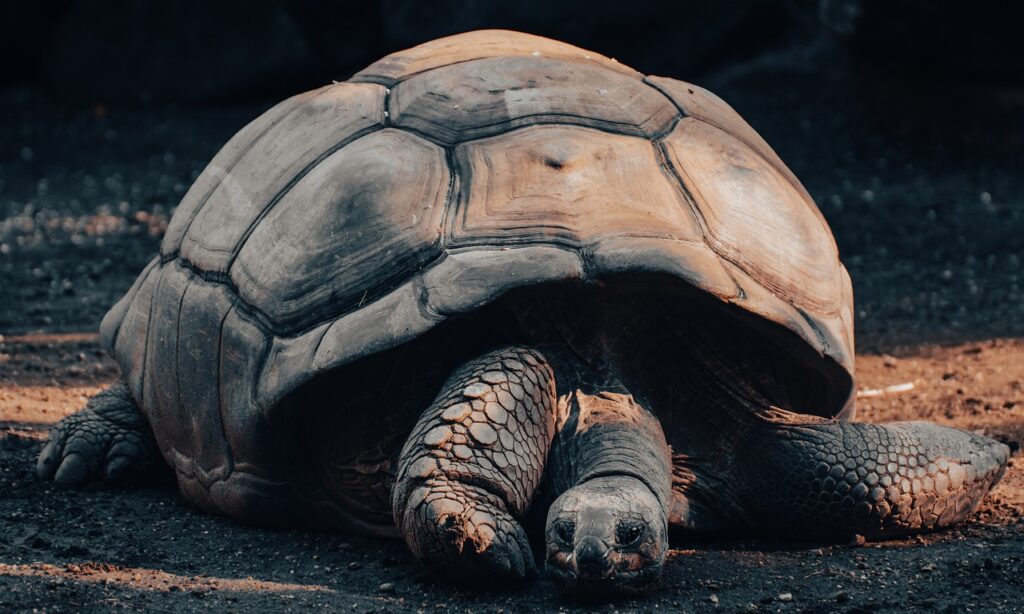Tortoises are captivating creatures that have held the attention of nature lovers for ages. They are members of the Testudinidae family, known for their protective shells and slow gait. Read on to discover the largest of these reptiles.
These shelled creatures come in many sizes, but some species are incredibly large! Take the Galapagos tortoise (Chelonoidis nigra). Found in the Galapagos Islands, Ecuador, these giants can weigh up to 500 pounds and measure over five feet long. Plus, they can live for over 100 years!
The Aldabra tortoise (Aldabrachelys gigantea) is another giant from the remote Aldabra Atoll in Seychelles. Some individuals reach 600 pounds! These slow-moving, gentle giants are symbols of endurance and resilience.
But, the Galapagos and Aldabra tortoises aren’t the only enormous ones. African spurred tortoises (Centrochelys sulcata) from Sahara Desert regions can grow to around three feet long and weigh up to 200 pounds. The same goes for the Burmese mountain tortoise (Manouria emys).
In addition, Galapagos tortoises had a big role in Charles Darwin’s evolutionary theory. When he visited the Galapagos Islands, he noticed differences in shell shape among various populations. This realization was key to his concept of adaptation through natural selection.
Move over Godzilla! These tortoises could give you a run for your money in the ‘biggest, baddest reptile’ category.
Key Takeaways
- The largest tortoises in the world are the Galapagos tortoise and the Aldabra tortoise.
- The Galapagos tortoise is native to the Galapagos Islands in the Pacific Ocean, while the Aldabra tortoise is found on the Aldabra Atoll in the Indian Ocean.
- Both species can reach impressive sizes, with some individuals weighing over 500 pounds and measuring over 5 feet in length.
- These tortoises have long lifespans, with some individuals living for over 100 years.
- The size and weight of these tortoises are adaptations that help them survive in their respective environments.
- Conservation efforts are being made to protect these tortoises and their habitats, as they are considered endangered species.
- The largest tortoises play an important role in their ecosystems, as they help disperse seeds and create habitats for other species.
Biggest Tortoise Species

Giant tortoises are fascinating creatures, renowned for their size! Let’s explore the biggest ones that roam our planet. Here’s what we know:
Galapagos Tortoise: Up to 6 feet long & up to 500 pounds.
Aldabra Giant Tortoise: Up to 4 feet long & up to 550 pounds.
The Galapagos holds the title for being the largest living species of tortoise. Scientists can identify individuals thanks to distinct shell patterns.
The Aldabra Giant Tortoise is native to the Aldabra Atoll. Its dome-shaped shell and slow movements aid in dispersing seeds.
If you ever come across these giants, remember a few things. Respect their space and don’t touch them. Follow the rules of national parks or reserves. This keeps you safe and preserves the ecosystems they live in.
Move over, slow and steady, these giant tortoises still win the title of the largest!
Giant Tortoise (Aldabra Tortoise)
Giant Tortoise (Aldabra Tortoise): A remarkable creature, boasting an impressive size and longevity! With an average lifespan of over 100 years, they inhabit the Aldabra Atoll in the Seychelles and can weigh up to 550 pounds and have a shell length of up to 5 feet.
These giants primarily feed on vegetation such as grass and leaves and their long necks and legs allow them to reach higher vegetation. They act as a keystone species, impacting plant populations and shaping the ecological balance on their island home.
Amazingly, the Aldabra Tortoises were believed to be extinct until their rediscovery in the late 19th century. This is a testament to their resilience and the conservation efforts to protect them. Move slow and live long – just like the Galapagos Tortoise!
Galapagos Tortoise

The Galapagos Tortoise is one of a kind. It’s the biggest living tortoise on the planet! It typically weighs up to 500 pounds and has an impressive lifespan of over 100 years. Plus, its shell can measure up to 4 feet in length.
- Habitat: On different islands of the Galapagos archipelago, these tortoises have adapted to various environmental conditions.
- Diet: This species eats vegetation like grasses, cacti, and fruits. They’re also able to store large amounts of water in their bodies, so they can go without it for a while.
- Reproduction: Males fight for territory and access to females in a special mating ritual.
- Conservation: To keep these creatures from extinction, conservation programs have been established. These include habitat restoration and breeding programs.
Pro Tip: If you ever spot a Galapagos Tortoise out in the wild, don’t disturb or feed it. Observe from a distance and let’s make sure we preserve these majestic creatures for future generations to admire.
Seychelles Giant Tortoise
The Seychelles Giant Tortoise is an amazing creature known for its massive size and interesting traits. Let’s explore these incredible creatures and their unique features.
Now, let’s break down what makes the Seychelles Giant Tortoise so special with this well-structured table:
| Characteristic | Details |
|---|---|
| Scientific Name | Aldabrachelys gigantea |
| Average Lifespan | 80-120 years |
| Native Habitat | Aldabra Atoll, Seychelles |
| Diet | Herbivorous, mainly grass and fruit |
| Size | Up to 4 feet long and 500+ pounds |
The Seychelles Giant Tortoise is special in many ways. It has a domed shell that protects it from predators and bad weather. This adaptation also helps it survive in places with little water.
Males of this species have interesting courting rituals during mating season. They butt heads and make loud bellowing sounds to attract females.
You might be mesmerised by the Seychelles Giant Tortoise. If you’re keen to see it up close, go to its native habitat – the Aldabra Atoll in Seychelles. Don’t miss out on experiencing one of nature’s true wonders!
African Spurred Tortoise

The African Spurred Tortoise, or Sulcata Tortoise, is one of the biggest tortoises in the world. Here are 6 key facts about this creature:
- They can reach 30 inches long and weigh over 100 pounds.
- They live up to 70 years, making them long-lived reptiles.
- They are native to the sub-Saharan region of Africa, mainly the Sahara Desert and its areas.
- Their shells have distinctive scales that protect them from predators and hostile environments.
- They are herbivores, mainly eating grasses, leaves, and fruits.
- People find them fascinating pets because of their size and unique look.
These tortoises have an adaptation that lets them store water. The keratinized skin on their legs lowers moisture loss in arid places.
Did you know that the largest recorded African Spurred Tortoise weighed an incredible 231 pounds? This amazing specimen was found in the wild and documented by Guinness World Records.
Frequently Asked Questions
Q: What are the largest tortoises in the world?
A: The largest tortoises in the world are the Galapagos tortoise and the Aldabra giant tortoise.
Q: How big do Galapagos tortoises get?
A: Galapagos tortoises can reach weights of over 900 pounds (400 kilograms) and have carapace lengths of up to 5 feet (1.5 meters).
Q: What is the average size of an Aldabra giant tortoise?
A: The average size of an Aldabra giant tortoise is around 550 pounds (250 kilograms) and they can have carapace lengths of up to 4 feet (1.2 meters).
Q: Where do Galapagos tortoises live?
A: Galapagos tortoises are native to the Galapagos Islands, which are located in the Pacific Ocean off the coast of Ecuador.
Q: Where are Aldabra giant tortoises found?
A: Aldabra giant tortoises are native to the Aldabra Atoll in the Seychelles, which is an archipelago in the Indian Ocean.
Q: Are Galapagos tortoises and Aldabra giant tortoises endangered?
A: Yes, both Galapagos tortoises and Aldabra giant tortoises are considered endangered species.
Conclusion
Giant tortoises are mysterious creatures that draw the attention of many. They have big sizes and long lives, giving us a view of the olden days and the amazing power of evolution.
The biggest tortoises are found in the Galapagos Islands and Aldabra Atoll. These places give the tortoises food and safety from enemies. Over time, they have become adapted to their surroundings, making them huge and distinct.
Their shells are remarkable too! They protect the tortoises and store water in dry periods. This helps them to cope with difficult times.
One famous tortoise was Lonesome George. He was from the Pinta Island, and he was the last of his kind. Attempts to match him with a mate failed and he died in 2012. His story is a reminder of how we should protect and conserve these amazing animals.
References




